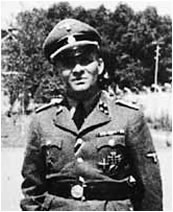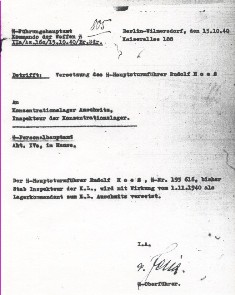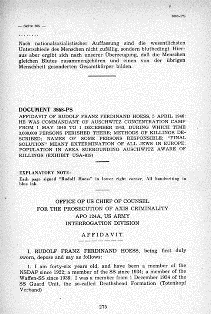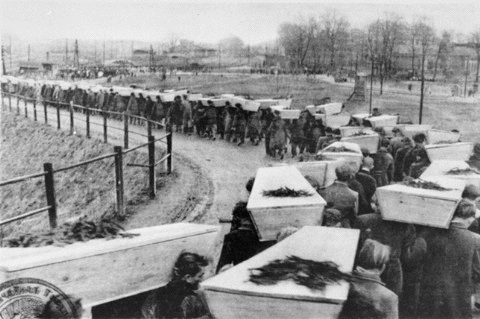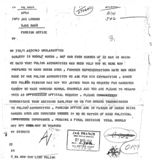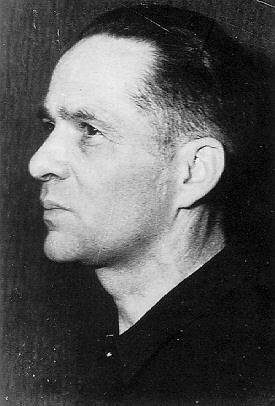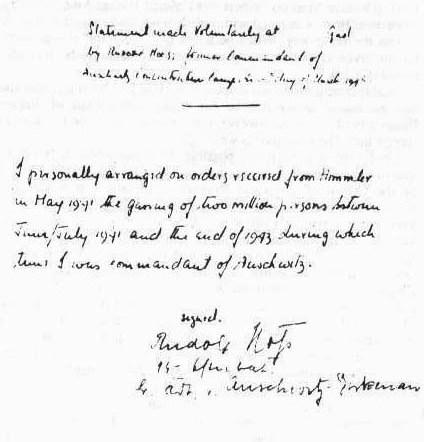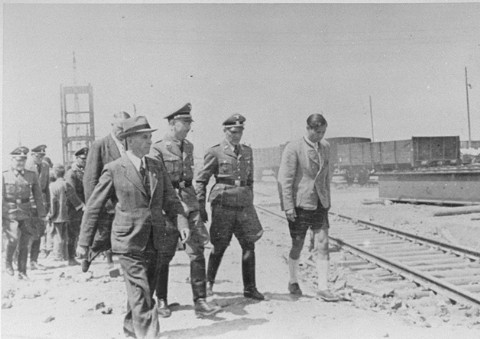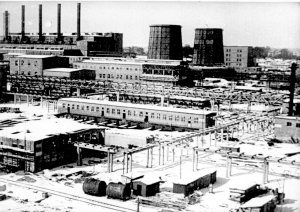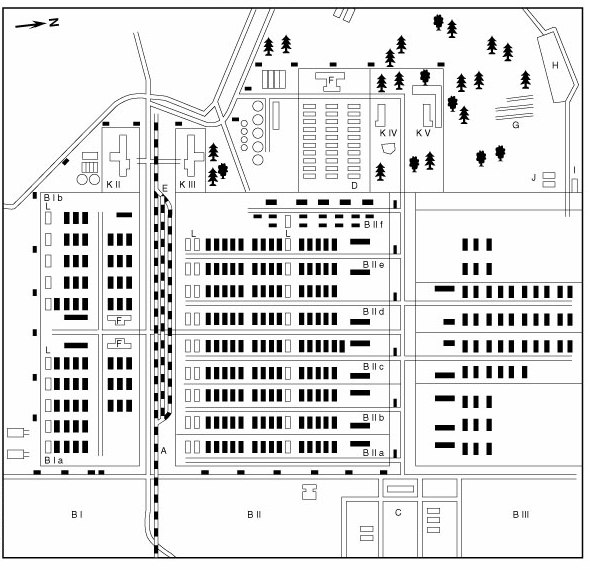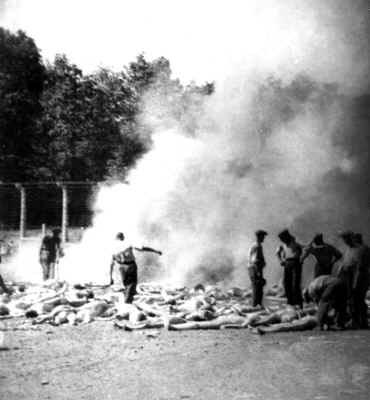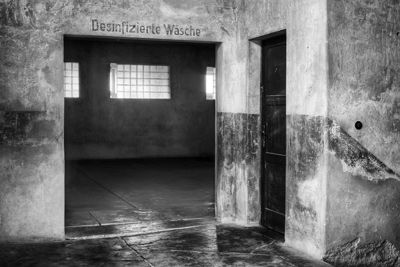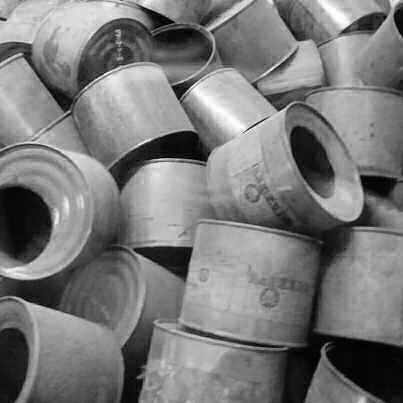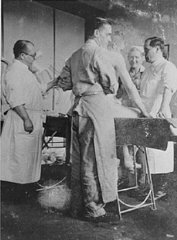I Rudolf Franz Ferdinand Höss, alias Franz Lang, hereby declare, after having been warned accordingly, that the following statement is true: In 1933 I formed a squadron of horse SS on the farm Sallentin in Pommern. I was detailed by the Party and by landowners to do this as I have been in the cavalry. My party number is 3240. Himmler noticed me during an inspection of the SS in Stettin – we knew each other from the Bund der Artamanen – and he arranged that the administration of a Concentration Camp was given me. I came to Dachau in November 1934 where, after additional military training, I was employed as a Blockfuhrer in the Schutzhaftlager. Later on I did the job of a Rapportfuhrer and Gefangenenigentumsverwalter When I came to Dachau I held the rank of Scharfuhrer SS and was promoted, in 1935, SS Untersturmfuhrer. In 1938 I was sent, as Adjutant, to the Camp Commandant of Sachsenhausen, Oberfuhrer Barananowski. In November 1938 I was made Schutzhaftlagerfuhrer holding the rank of a SS- Hauptsturmfuhrer until my transfer to Auschwitz on the 1 May 1940. I was given the order by a higher authority, to transform the former Polish Artillery Barracks near Auschwitz into a quarantine camp for prisoners coming from Poland. After Himmler inspected the camp in 1941 I received the order to enlarge the camp and to employ the prisoners in the, to be developed agricultural district, and to drain the swamps and inundation area on the Weichsel. Furthermore he ordered to put 8 – 10,000 prisoners at the disposal of the building of the new Buna Works of the I.G. Farben. At the same time he ordered the erection of a POW Camp, for 100,000 Russian prisoners, near Birkenau. The number of prisoners grew daily in spite of my repeated interventions that billets were not sufficient, and further intakes were sent to me. Epidemic diseases were unavoidable because medical provisions were inadequate. The death rates rose accordingly, as prisoners were not buried, crematoriums had to be installed. In 1941 the first intakes of Jews came from Slovakia and Upper Silesia. People unfit to work were gassed in a room of the crematorium in accordance with an order which Himmler gave me personally. I was ordered to see Himmler in Berlin in June 1941* and he told me, approximately, the following: The Fuhrer ordered the solution of the Jewish question in Europe. A few so called Vernichtungslager are existing in the General Government. These camps come under the Einsatzkommando of the Sicherheitspolizei under the leadership of high SIPO officers and guard companies. These camps were not very efficient and could not be enlarged. I visited the camp Treblinka in spring 1942 *** to inform myself about the conditions. The following method was used in the process of extermination. Small chambers were used equipped with pipes to induce the exhaust gas from car engines. This method was unreliable as the engines, coming from old captured transport vehicles and tanks, very often failed to work. Because of that the intakes could not be dealt with according to the plan, which meant to clear the Warsaw Ghetto. According to the Camp Commandant of Treblinka, 80,000 people have been gassed in the course of half a year. **** For the above mentioned reasons Himmler declared the only possibility to extend this camp, in accordance with this plan was Auschwitz, as it was a railway junction of four lines and, not being thickly populated, the camp area could be cut off completely. This is the reason why he decided to do the mass exterminations in Auschwitz and I had to make the preparations at once. He wanted the exact plan in accordance with this instruction in four weeks. Furthermore he said this task is so difficult and important that he cannot order just anybody to do it and he had the intention to give this task to another high ranking SS officer but he did not consider it advisable to have two officers giving orders whilst on a construction job. I was then given the definite order to carry out the destruction of the intakes sent from RSHA. I had to get in touch with SS Obersturmbannfuhrer Eichmann of Amt 4 (Dienststelle commanded by Gruppenfuhrer Muller) concerning the sequence of incoming transports. At the same time transports of Russian P.O.W. arrived from the area of the Gestapo Leitstelle Breslau, Troppau, and Kattowitz, who, by Himmler’s written order to the local Gestapo leaders, had to be exterminated. As the new crematoriums were only to be finished in late 1942, the prisoners had to be gassed in provisionally erected gas-chambers and then had to be burned in pits. I am now going to explain the method of gassing. The sick and people unfit to walk were taken there in lorries. In front of the farmhouses everybody had to undress behind walls made from branches. On the door was a notice saying “Disinfectionsraum.” The Unterfuhrer on duty had to tell the prisoners to watch their kit in order to find it again after having been deloused, this prevented disturbances. When they were undressed, they went into the room according to size, 2-300 at a time. The doors were locked and one or two tins of zyklon B were thrown into the room through holes in the wall. It consisted of a rough substance of Prussic acid. It took, according to the weather 3-10 minutes. After half an hour the doors were opened and the bodies were taken out by the commando of prisoners, who were permanently employed there, and burned in pits. Before being cremated, gold teeth and rings were removed. Firewood was stacked between the bodies and when approximately 100 bodies were in a pit, the wood was lighted with rags soaked in paraffin. When the fire had started properly more bodies were thrown on to it. The fat which collected in the bottom of the pits was put into the fire with buckets to hasten the process of burning when it was raining. The burning took 6 -7 hours. The smell of the burned bodies was noticed in the camp even if the wind was blowing from the west. After the pits had been cleaned the remaining ashes were broken up. This was done on a cement platter where prisoners pulverised the remaining bones with wooden hammers. The remains were loaded on lorries and taken to an out of the way place on the Weichsel and thrown into the river. After the erection of the new big crematorium, the following method was used. After the first two big crematoriums were finished in 1942 (the other two were finished half a year later) mass transports from Belgium, France, Holland and Greece started. The following method was used: The transport trains ran alongside an especially built ramp with three lines which was situated between the crematorium, store and camp Birkenau. The sorting out of the prisoners and the disposing of the luggage was done on the ramp. Prisoners fit to work were taken to one of the various camps, prisoners to be exterminated were taken to one of the new crematoriums. There the first went to one of the big underground rooms to address. This room was equipped with benches and contraptions to hang up clothing and the prisoners were told by interpreters that they were brought here to have a bath and be deloused and to remember where they put their clothing. Then they went on to the next room which was equipped with water pipes and showers to give the impression of a bath. Two Unterfuhrers remained in the room until the last moment to prevent unrest. Sometimes it happened that prisoners knew what was going to be done. Especially the transports from Belsen knew, as they originated from the East, when the trains reached Upper Silesia, that they were most likely taken to the place of extermination. When transports from Belsen arrived safety measures were strengthened and the transports were split up into smaller groups which we sent to different crematoriums to prevent riots. SS men formed a strong cordon and forced resisting prisoners into the gas-chamber. That happened very rarely as prisoners were set at ease by the measures we undertook. I remember one incident especially well. One transport from Belsen arrived, approximately two-thirds, mostly men were in the gas- chamber, the remaining third was in the dressing room. When three or four armed SS Unterfuhrers entered the dressing room to hasten the undressing, mutiny broke out. The light cables were torn down, the SS men were overpowered, one of them stabbed and all of them were robbed of their weapons. As this room was in complete darkness wild shooting started between the guard near the exit door and the prisoners inside. When I arrived I ordered the doors to be shut and I had the process of gassing the first party finished and then went into the room together with the guard carrying small searchlights pushing the prisoners into a corner from where they were taken out singly into another room of the crematorium and shot, by my order, with small calibre weapons. It happened repeatedly that women hid their children underneath their clothing and did not take them into the gas chamber. The clothing was searched by the permanent commando of prisoners under the supervision of the SS and children who were found were sent into the gas-chamber. After half an hour the electric air conditioner was started up and the bodies were taken up to the cremating stove by lift. The cremation of approximately 2,000 prisoners in five cremating stoves took approximately 12 hours. In Auschwitz there were two plants, each of them had five double stoves. Furthermore there were another two plants, each having four bigger stoves and provisional plants as described above. The second provisional plant had been destroyed. All clothing and property of prisoners was sorted out in the store by a commando of prisoners which was permanently employed there and was also billeted there. Valuables were sent monthly to the Reichsbank in Berlin. Clothing was sent to armament firms, after having been cleaned, for the use of forced labour and displaced persons. Gold from teeth was melted down and sent monthly to the medical department of the Waffen –SS. The man in charge was Sanitaetsfeldzeugmeister SS – Gruppenfuhrer Blumenreuter. I personally never shot anybody or beat anybody. Owing to the mass intakes, the number of prisoners fit to work grew immensely. My protests to the RHSA to slow down the transports, which means to send fewer transports, was rejected every time. The reason given was the Reichsfuhrer SS had given an order to speed up extermination and every SS Fuhrer hampering same will be called to account. Owing to the immense over- populating of existing barracks and owing to the inadequate hygienic installations, epidemic diseases like spotted fever, typhus, scarlet fever and diphtheria, broke out from time to time, especially in the camp Birkenau. Doctors came under the camp commandant from a military point of view. As far as medical decisions went, they had their own routine and came under the Chef des Sanitatswesens des WVHauptamtes Standartenfuhrer Dr. Lolling, who again came under Reichsarzt Dr Gravitz. In one respect the above mentioned rule has been broken – local Gestapo leaders were given orders by RHSA to get in touch with me. Prisoners which were kept in concentration camps for the Gestapo and who have not been sentenced out of political reasons were allowed to be removed by any other means. I received the names of the persons, personally, from the leader of the Gestapo and I passed them on again to the respective doctor for finishing off. This, usually was an injection of petrol. The doctor had orders to write an ordinary death certificate. Regarding the reason of the deaths, he could put any illness. During the time as Commandant we made the following experiments: Professor Clauberg, chief of the Women’s Hospital, Konigshutte, in Upper Silesia, made sterilisation experiments. This was done as follows. He got in contact with the doctor of the women’s camp to find him suitable persons. They were put in a special ward of the hospital. Under a special x-ray screen he gave them a syringe with a special liquid, which went through the womb into the ovary. This liquid, as he said, definitely blocked the ovary and caused an inflammation. After a few weeks he gave them another injection which could tell him that the ovary was definitely blocked. These experiments were made by order of the Reichsfuhrer SS. -Rudolf Franz Ferdinand Höss | 